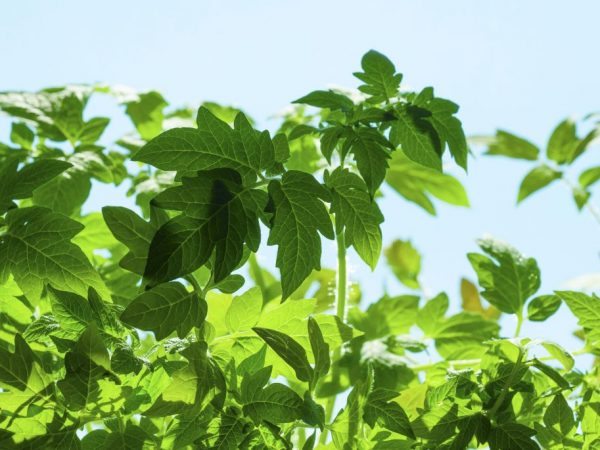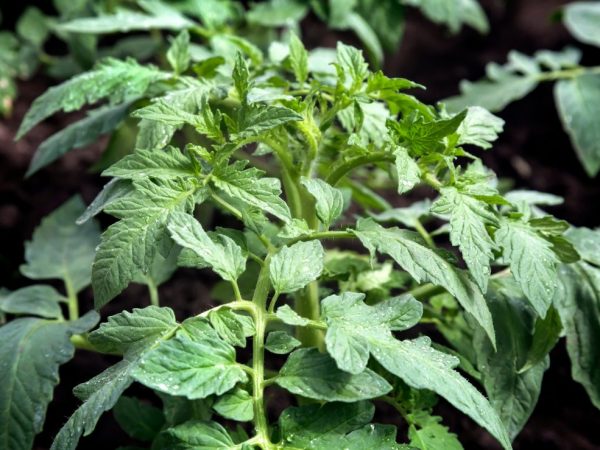Why tomatoes fatten in a greenhouse
When growing tomatoes, you must follow the basics of care. Violation of the technique of growing tomatoes can lead to fattening of the plants. The process is observed both in greenhouses and in the open. Most often, tomatoes are fattened in a greenhouse.

Reasons for fattening tomatoes in a greenhouse
Signs of fattening
The signs are determined by the appearance and quality of the crop:
- The tomato bush looks healthy and powerful, but its disease resistance is decreasing. All nutrients and energy of the plant go to the development of the vegetative mass. The upper leaves on the bushes curl up and thicken. They change color to dark green.
- The plant has new shoots. The stems thicken. A strong external root system is formed.
- The fruits become small and sparse. Their maturation is delayed. Often the bush does not bloom or does not form ovaries, which leads to a poor harvest.
Reasons for fattening
Tomatoes are fattened in the greenhouse when overfeeding with organic fertilizers occurs, especially before flowering. Manure, green manure, compost are rich in nitrogen, which stimulates the growth of the vegetative system of the plant.
Also, a problem may arise due to high humidity, due to frequent watering. An excess of water leads to the fact that vegetables cannot provide nutrition on their own.
Tatiana Orlova (Candidate of Agricultural Sciences):
An excess of water in plants leads to the fact that each plant cell is abundantly saturated with it and increases in size several times. As a result, the overall size of the plant increases. In addition, the walls of the cells when stretched become thin (by analogy with a balloon) and easily accessible for the penetration of pathogens. Such plants are often susceptible to various diseases.
Lack of light due to poor sunlight or additional artificial lighting can provoke fattening. Light starvation entails a deterioration in flowering, especially in southern varieties.
An additional factor is the thickened planting of seedlings. Strongly high or low temperatures during the day and especially at night are negatively affected. Moisture from the soil evaporates poorly. The plant receives less light. This leads to the fact that the tomatoes are fattening in the greenhouse.
Fighting fat gain
Immediately after the discovery of fatty bushes, emergency measures are taken to save them. It is necessary to stop watering and irrigating the bushes for 7 days to stop the active growth of the green mass of the plant.
The greenhouse is ventilated. Eliminate nitrogen fertilization to stop root growth. Such dressings are suitable for small seedlings with a weak root system. In adult tomatoes, they lead to fattening.
Tatiana Orlova (Candidate of Agricultural Sciences):
Nitrogen fertilizers are applied only in the initial period of growth. The first feeding with nitrogen fertilizers is carried out 7-10 days after planting the seedlings. In cold weather, tomato roots do not work well, nitrogen is almost not absorbed. Because of this, the plants seem weak and they again begin to intensively feed them with nitrogen.With the establishment of warm weather, tomato plants quickly begin to use this over-applied nitrogen and delay growth without proceeding to flowering.
Top dressing
Make up a feeding schedule depending on the variety of tomatoes. Hybrid tomatoes and varieties with a long flower cluster fatten even with a small amount of fertilizer.
Foliar feeding of tomatoes is carried out - spraying of stems and leaves with a weak solution of phosphorus fertilizers is done.
After foliar dressing, the spraying result can be seen the very next day. Such fertilizers act immediately, but, unlike root dressings, the result does not last long.

Top dressing will increase the number of ovaries
To consolidate the result, additional root feeding is carried out with a superphosphate extract.
Prepare it as follows:
- 100 g of double granulated superphosphate is poured into 1 liter of boiling water. The solution is stirred and left for a day until complete dissolution.
- 20 tablespoons of this mixture are poured into 3 liters of water. Insist until smooth.
- 150 g of this new solution is mixed with 1 bucket of water. Plants are fertilized at the root of 1 liter for each bush.
This procedure will increase the amount of ovary. Before feeding, vegetables are watered abundantly.
An excellent result is obtained by root feeding with magnesium. The element restores the balance of nutrients in the soil and prevents leaf curling and shoot growth. On acidic soils, magnesium turns into complexes that are insoluble and inactive for plants. That is, it becomes inaccessible to them. On acidic soils, fertilizers containing magnesium (magnesium sulfate) are best given as foliar treatments. Or add dolomite flour before using the soil.
Care when fattening
The microclimate in the greenhouse is improved, incl. monitor the temperature. Its indicators increase to 25 ° in the daytime, and at night it should not fall below 22.
Provides good access to sunlight and regulates special lighting. This will help to lower the humidity in the air. Remove all the leaves that grow above the flower clusters and close the ovaries from light. They do this not immediately, so as not to stress the tomatoes. No more than 2-3 sheets are torn off per day.
The bushes are freed from stepchildren. This is done with pruning shears with a length of 3.5 cm. Stumps are not left from shoots, which will protect against fattening and pathogenic microflora.
Forced pollination is an effective measure for fattening. To do this, the tomato flowers are periodically shaken. No more than 6-7 flowers are left in the ovary. The rest are pinched. In this case, the yield will be smaller, but all flowers will ripen to fruit.
Watering tomatoes is resumed after 7 days with warm water under the root. The soil is loosened to evaporate moisture.
These measures will stop the growth of green mass and redirect nutrients to the formation of buds and fruits of the crop.
Prophylaxis
Wood ash is added to the soil before planting. It is rich in potassium. Such soil will not allow seedling in the early stages. The soil is dug up for air and moisture exchange.
- In the first 15 days after planting, seedlings are vulnerable to fattening. At this time, you cannot water the vegetable abundantly and apply a lot of fertilizers. Watering no more than 2 times a week. During flowering, it is necessary to further reduce irrigation.
- To determine the moisture content of the soil, a handful of earth is taken from a depth of 15 cm and squeezed in the palm of your hand. The earth does not disintegrate - no watering is needed, scattered - moisture is required.
- The soil must be mulched in order to water less often. Mulch retains moisture at the roots.
- You should regularly inspect the stems and leaves, and at the first symptoms of fattening, take the described measures.
Conclusion
To protect against fattening, choose tomato varieties that are less prone to this process. Tomatoes with a short bristle, as well as determinant varieties of tomatoes, are practically not susceptible to manifestations of such a disease.



